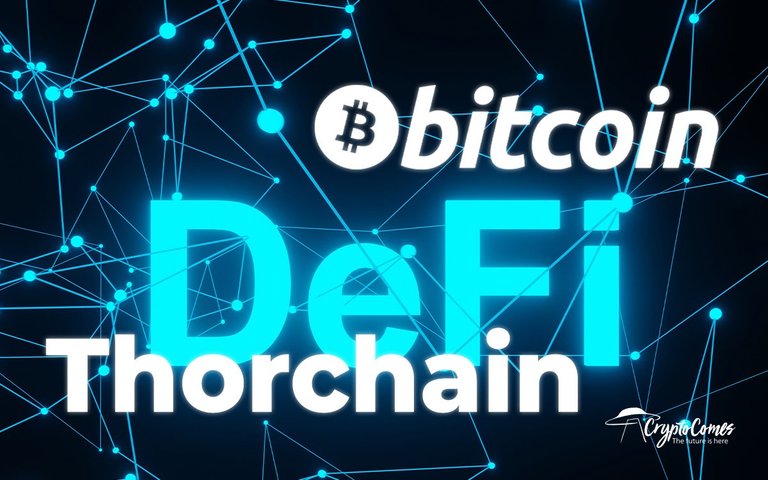
Decentralized finance with native assets, and no bridges or asset representative tokens, which allows trustlessness.
I recently wrote a post about the recent Solana Bridge Hack, worth millions of dollars My Post. The core cause of the theft was a security vulnerability in the bridge used to connect the Ethereum blockchain to the Solana blockchain. That vulnerability was caused by the bridge being trusted, versus trustless. The state of Trustlessness is a core or central part of cryptographic transaction security. We give up this important element of cryptographic security to facilitate cross block chain investment, when we use wraps, swaps and bridges. In this post I would like to discuss how Thor-chain is an attempt to fix this issue, or solve the loss of cryptographic security created by bridges, swaps, wraps and other synonymous activities. But before we discuss Thor-chain , we should discuss some of the terminology we will use in this discussion to facilitate understanding.
All blockchains have two main types of tokens:
Tokens representing native assets, or assets native to that chain, as in Ether is native to the Ethereum blockchain.
Tokens representing non-native assets, or assets which are not native to that chain, such as a token representing Bitcoin on the Ethereum blockchain.
Native or Non-native Tokens Discussion:
Bitcoin is a token on the Bitcoin blockchain. It is a native token of the Bitcoin blockchain.
Bitcoin is not a native to the Ethereum blockchain, therefore it is a non-native token.
Blockchains only allow native tokens to transact there.
Therefore the native Bitcoin token or asset cannot transact or be traded on the Ethereum blockchain, and investors who own native Bitcoin cannot invest native Bitcoin on the Ethereum blockchain, in its native state.
Therefore investors who own Bitcoin cannot take advantage of investment opportunities on Ethereum, mainly decentralized finance. This is a problem and the solution to this problem is called swapping, or wrapping or bridging.
So to move the value of your Bitcoin, you swap it for a special token, a token native to the Ethereum blockchain, and that special token represents the value of your Bitcoin on the Ethereum blockchain.
For ease of discussion we can called it Wrapped Bitcoin, in reference to the process called wrapping, which allows us to move the value of our Bitcoin from the Bitcoin blockchain to the Ethereum blockchain. It is called wrapped bitcoin, and it is a token representing the value of our native Bitcoin on the Ethereum blockchain.
This process is called wrapping, and it is also called swapping, and in the case of swapping, the token on the Ethereum blockchain representing our native Bitcoin, can be called swapped bitcoin. This term swapped bitcoin is grammatically confusing, so it’s used less then the term wrapped bitcoin. Lastly, this same or a very similar process is called bridging. In bridging you get to hear another word bridge tokens. Did your head explode yet?
All these terms wraps, swaps and bridges are functionally, as in what goal they achieve, synonyms. But you can see the difficulty in explanations using so many terms. Most importantly; All of these involve trust, and lack transparency. It’s important to know or remember that Trustlessness and Transparency are two of the five pillars of cryptographic security. The foundation of cryptocurrency security is built on five pillars, two are missing here. It’s important to note this is not criticism of bridges, swaps, wraps or their creators. This is just information about what is and what isn’t.
The solution to the problem of native and non-native tokens in cross blockchain trading wraps, swaps or bridges are trusted solutions.
When decentralized finance started on Ethereum it was very profitable, and many traders owning tokens which were not native tokens on the Ethereum blockchain sought ways to move the value of their non-native tokens to Ethereum, as native tokens.
Wraps, swaps and bridges became the accepted way of doing this, and this solution allowed thousands of investors to invest their non-native tokens value on the Ethereum blockchain, as a special type of Ethereum tokens, which was native to the Ethereum blockchain, but represented not the value of ether, but the value of the non-native tokens on Ethereum. This is a mouthful of native and non-native, but I hope you see now how precision in explanation is important. We need to understand the problem first, then it’s easy to understand the solution.
Cryptographic security and cross blockchain trading.
The problem with cross blockchain security is that it requires the investor to surrender control of their tokens native to one blockchain, to a middleman. This middleman then holds the native asset on the native blockchain, and gives the investor another token, on another blockchain, which represents the value of the original asset on the first blockchain, on the second blockchain. This is called trust or a trusted solution, and it is the opposite of trustlessness.
That’s a mouthful, better explained by example.
You want to trade your Bitcoin, a native asset of the blockchain, on another blockchain Ethereum. You surrender your asset Bitcoin, to a middleman on the Bitcoin blockchain, who then gives you another asset or token, which is a native token on the Ethereum blockchain, which represents the value of your Bitcoin, on the Ethereum blockchain. This would look like this. You send 10 Bitcoin to a Bitcoin wallet controlled by the Bridge called Bitcoin-Ethereum Bridge. Your native Bitcoin stays there. The Bitcoin-Ethereum Bridge operator sends 10 tokens, to your wallet on the Ethereum blockchain, these 10 tokens are called wrapped Bitcoin, and they are native tokens, on the Ethereum blockchain, which represent the value of your native Bitcoin on the Ethereum blockchain.
cryptographic security relies on 5 pillars, one is trustlessness, so Trust is a security vulnerability.
The problem is that security on a blockchain is dependent on several factors, and one is trustlessness, meaning your tokens are always under the control of your private keys, in your wallet. This means they are in your custody or you possess them. Once you send your tokens to a bridge, they are no longer under the control of your private keys in your wallet, even though in theory you still own them, but you are no longer in custody of them, as in you no longer possess them.
This is a problem and we don’t intuitively recognize the gravity or seriousness of it, because we are coming from trusted centralized system; the legacy banking system. In the legacy banking system we trust the bank to custody or possess our money. So possession or custody isn’t such a big issue. However as cryptocurrency investors and traders, we are not in the legacy banking system, we are in the cryptocurrency system.
In this system custody or possession is synonymous with ownership and security. It’s not a design flaw, it’s a design feature. And it is an important part of security. Possession in the cryptocurrency system is the same as ownership.
We are all visitors to a new country, called cryptocurrency, where the rules are different, so we are vulnerable.
Thus the solution to this problem of cross blockchain trading, created a security problem, but most of the time it works fine. But every so often, and we don’t know how often, the bridge gets exploited and the funds are lost.
Thor-chain proposes a solution.
Thor-chain has many strengths as an ecosystem, and we will discuss just a few , in the name of brevity and allowing time for you to process this information. Thorchain is a proposed solution to this security vulnerability of cross chain trading, using swaps, wraps and bridges as previously described.
- Thor-chain allows you to use your native assets in decentralized finance projects, so you maintain control or possession of your assets.
- Thor-chain eliminates the trusted nature of swaps, wraps and bridges by providing native asset interaction because it eliminates the need for them.
- Thorchain allows you to swap assets directly from your wallet to another wallet, through liquidity pools made up of Thorchain’s native token Rune and many other tokens.
- Thor-chain allows you to maintain custody or possession of your assets, cryptographically protected in your wallet, by your private keys.
- Thor-chain allows you to preserve trustlessness and eliminates much of the trusted nature of the current DeFi ecosystem.
How does it work in practice.
I would refer you to the posts of those who write about their actual experiences, for a true reveal, but here is my understanding:
So Thorchain asset swap of Ethereum for Bitcoin would not require you to swap your native assets for any intermediate token to transact on another blockchain.
Thorchain allows you to come to Thorchain where there is a Rune-Bitcoin pool and a Rune Ethereum pool.
You send your Ethereum to the Rune Ethereum Pool, it’s swapped for Rune, then that Rune is sent to the Rune Bitcoin pool, where the Rune is swapped for Bitcoin.
Your Ethereum moves from your wallet to an Ethereum wallet, and the other side of the trade who has Bitcoin, their Bitcoin moves from their wallet to a Bitcoin wallet.
Then when the Thor blockchain is satisfied the wallets send one person Ethereum and another person Bitcoin.
Your Ethereum and the other parties Bitcoin stay in your wallet up until the trade commences.
In this way your native Ethereum and the other parties native Ethereum stay in your respective wallets, protected by your respective private keys, until you are ready to trade.
Summation
Cryptocurrency security is based on five pillars, two of which are the security of your private keys, and verification through transparency. As you can see, wraps, swaps and bridges are processes which are not transparent to all who use them, and the loss of cryptographic security over your tokens isn’t apparent either. These two things are why this is important. They are the antithesis or opposite of what cryptocurrency is about, and more importantly the opposite of what makes it secure. Thorchain is a proposed solution to this problem. Thorchain attempts to restore trustlessness and transparency, two pillars of cryptocurrency security.
Thorchain isn’t perfected
Thorchain is an exciting new project, and is one solution to a common problem. As new code it has it’s own vulnerabilities, and it is working on fixing them. But like everything in Defi and cryptocurrency, it is in the process of evolving to something better. Those of us who have chosen to invest in cryptocurrency must constantly remind ourselves that we are on the frontier of technology and finance. It’s dangerous, it’s exciting and it’s profitable. Fortunes are made and money is lost. But we are on a journey and we are sharing an experience that few will have, so be careful, do your own research, invest only what you can afford to lose.
This post penned by my hand, the 12th of February, 2022. @shortsegments

Posted Using LeoFinance Beta